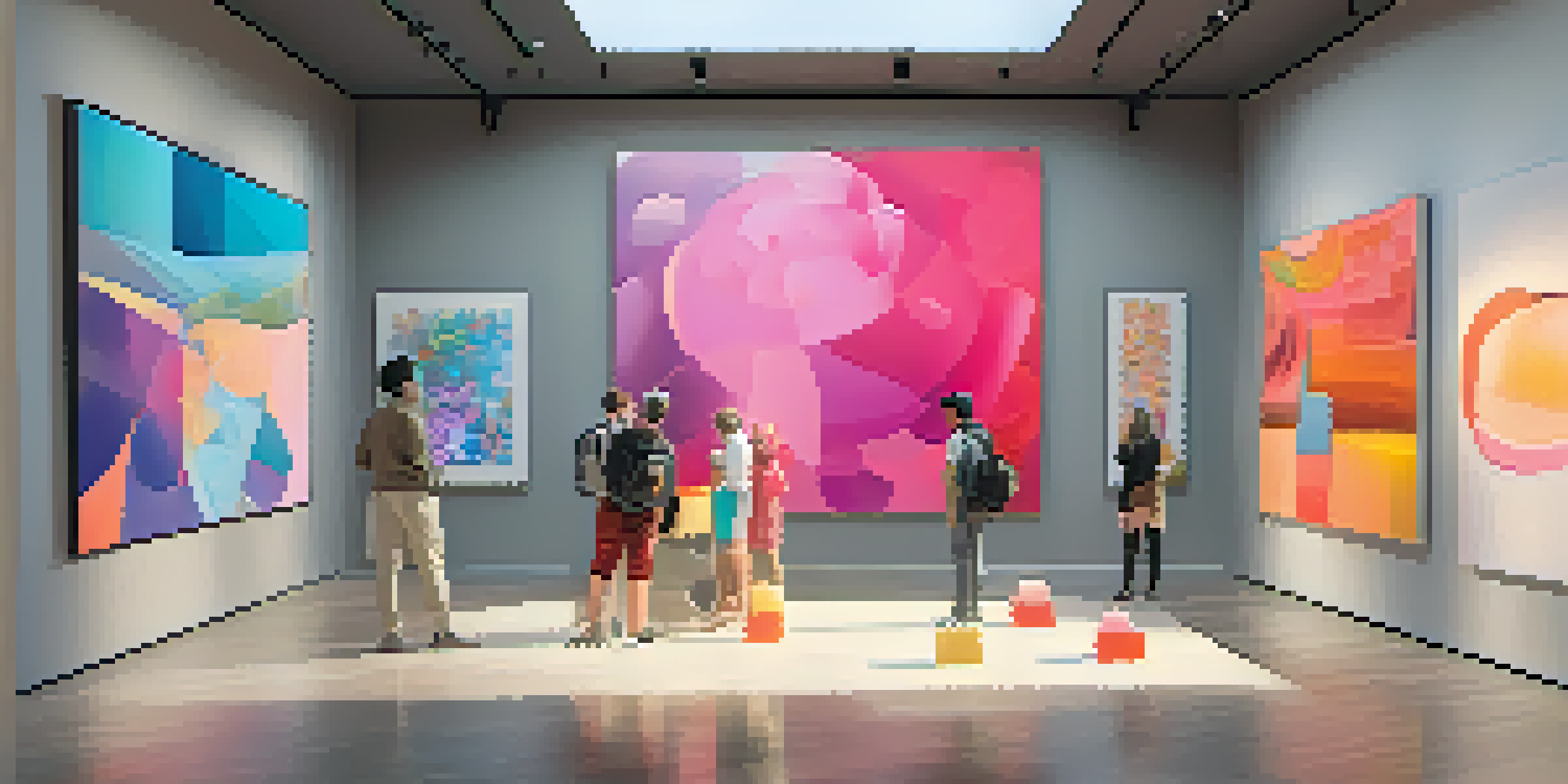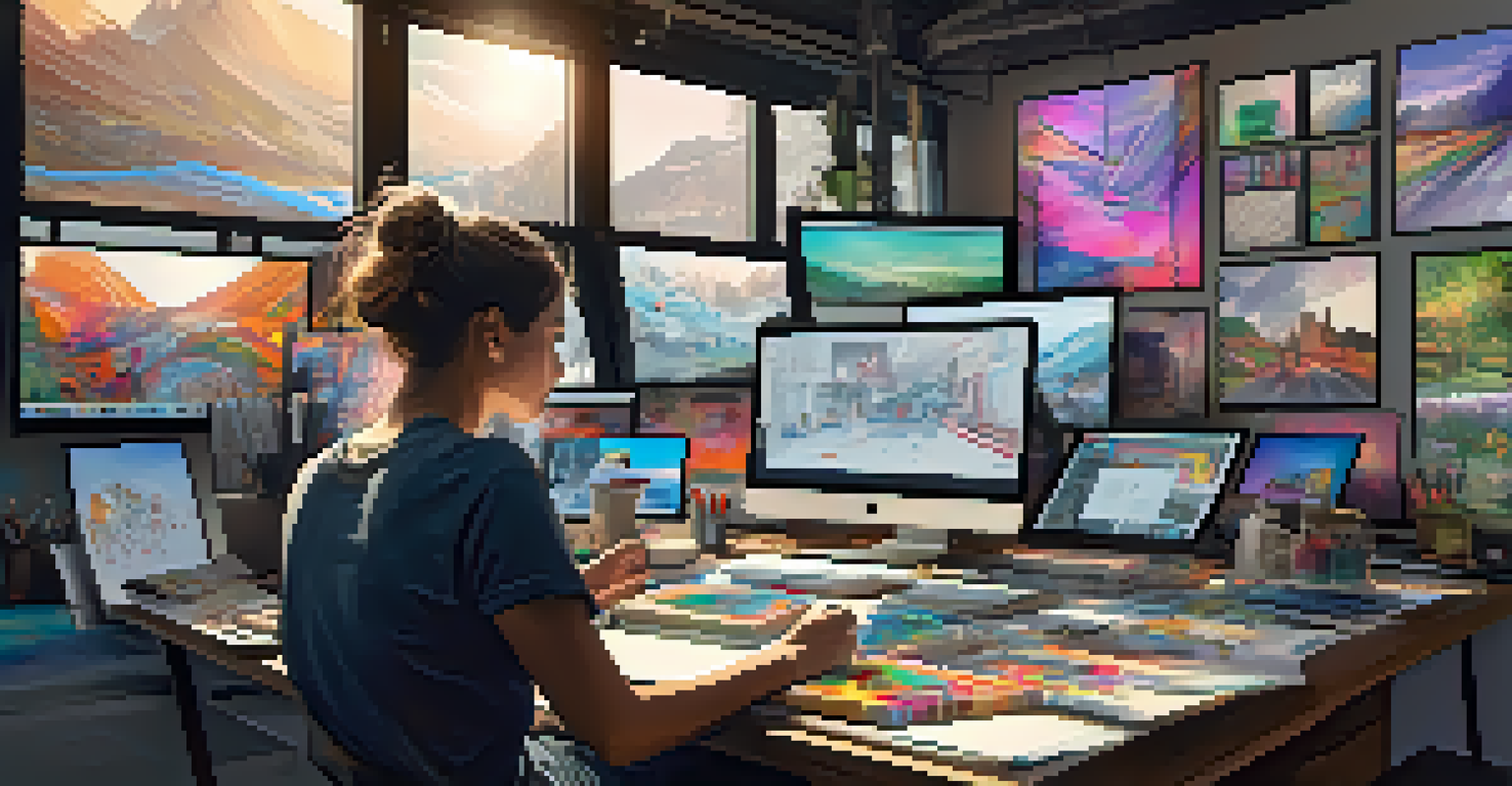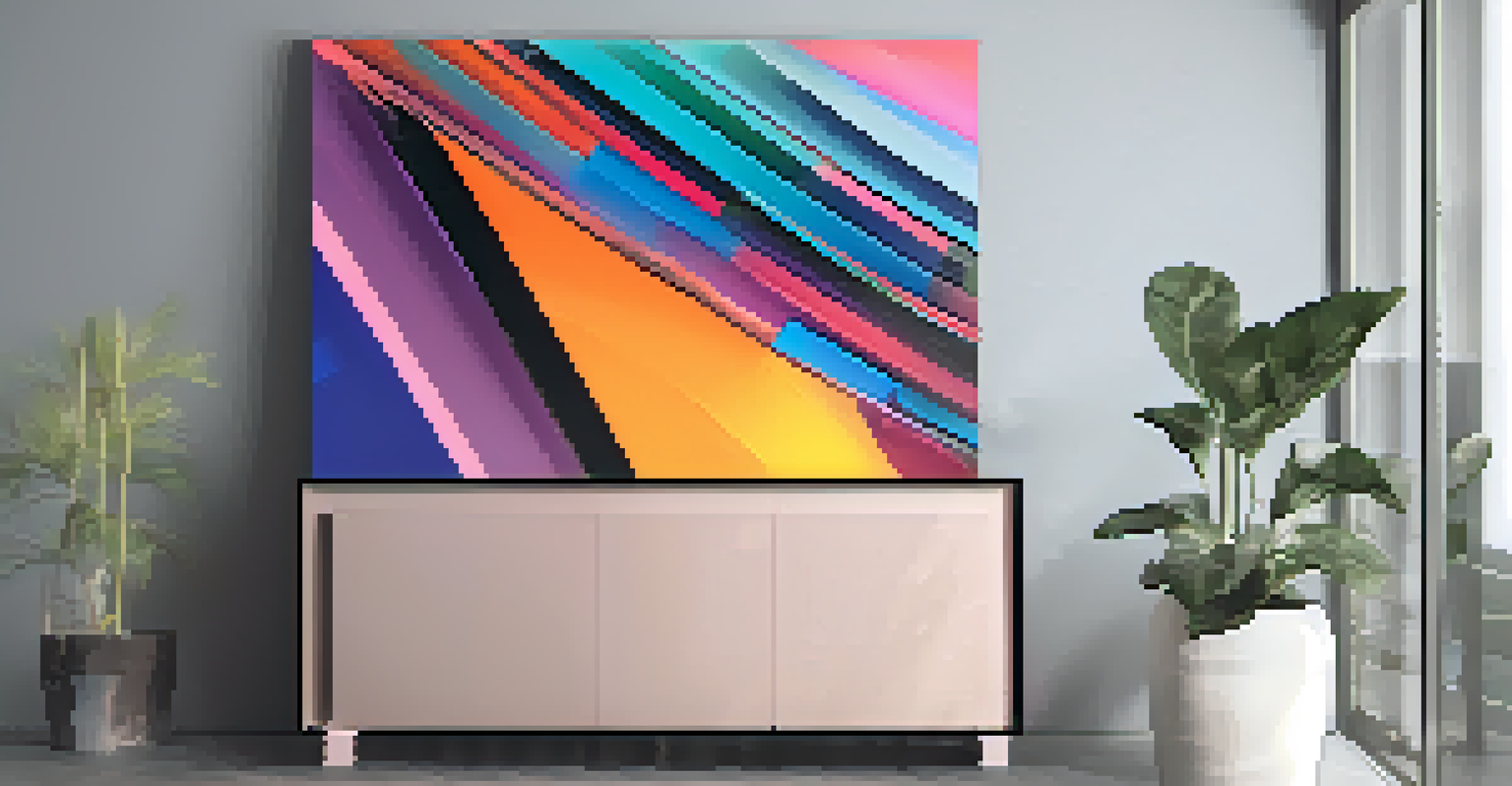Exploring the Aesthetic Appeal of Digital Art in NFTs

The Rise of Digital Art and NFTs in Popular Culture
In recent years, digital art has seen a meteoric rise in popularity, largely fueled by the emergence of NFTs, or non-fungible tokens. These unique digital assets allow artists to tokenize their work, providing proof of ownership and authenticity. As a result, artists who once struggled for recognition are now selling their creations for staggering amounts, captivating both collectors and the general public.
Digital art is a new canvas for creativity, allowing artists to explore and express their visions in ways that traditional mediums cannot.
This shift has opened up new opportunities for artists to express themselves and reach wider audiences. From established creators to newcomers, the NFT market has democratized access to art, giving everyone a chance to showcase their talent. Think of it as a modern art gallery, but one that exists in the digital realm, accessible from anywhere around the globe.
As we delve into the aesthetic appeal of digital art in NFTs, it’s essential to recognize how technology has transformed the art world. By blending creativity with innovation, digital artists are not only redefining what art can be but are also inviting us to rethink our relationship with ownership and value in the art market.
Understanding Digital Art: A New Medium of Expression
Digital art encompasses a wide range of creative outputs, from graphic design to digital painting and beyond. Unlike traditional art forms, digital art can be manipulated and shared in limitless ways, providing artists with the flexibility to explore their visions. This versatility often results in vibrant, dynamic pieces that push the boundaries of creativity.

For many, the ease of creating and sharing digital art has led to an explosion of new styles and movements. Imagine the thrill of a painter who can instantly adjust colors or experiment with textures without the limitations of physical materials. This freedom fosters an environment where innovation thrives, and each artist can develop a unique voice.
Digital Art Revolutionized by NFTs
The emergence of NFTs has transformed how artists create, share, and sell their work, leading to unprecedented opportunities in the digital art landscape.
Moreover, digital art often incorporates elements of interactivity and animation, offering a multi-dimensional experience that traditional art forms may lack. These characteristics not only enhance the viewer's engagement but also challenge our perceptions of art itself, inviting us to interact with and experience art in exciting new ways.
The Emotional Impact of Digital Art in NFTs
One of the most compelling aspects of digital art in the NFT space is its ability to evoke strong emotions and connect with audiences. Artists often pour their personal experiences, thoughts, and feelings into their work, allowing viewers to relate on a deeper level. This emotional resonance can be particularly powerful in a digital format, where visuals and sounds can combine to create immersive experiences.
NFTs are the new frontier for artists, providing them not just with a platform but also with a way to own and monetize their digital creations.
Consider how a piece of digital art, enhanced with sound or motion, can transport you to another world. This synergy between different mediums allows artists to convey complex narratives and feelings that might be harder to express through traditional means. It’s a form of storytelling that captivates viewers and invites them to reflect on their own experiences.
Furthermore, NFTs provide a platform for artists to share their stories and connect with communities that appreciate their work. The ability to own a piece of art that carries a personal narrative creates a sense of belonging and fosters a deeper connection between the artist and the audience.
Exploring Diverse Styles in Digital Art and NFTs
The world of digital art is incredibly diverse, with styles ranging from hyper-realistic 3D renderings to whimsical illustrations and abstract compositions. This variety means there’s something for everyone, whether you’re drawn to the intricate details of a digital painting or the bold colors of a graphic design piece. Each style offers a different aesthetic experience, showcasing the vast potential of digital creativity.
Artists often blend techniques and inspirations from various sources, creating hybrid styles that reflect contemporary culture. Imagine a piece that combines elements of street art with digital animation, creating a vibrant commentary on society. This fusion not only makes digital art visually striking but also enriches the narratives being told.
Community Drives Digital Art Success
A strong sense of community among artists and collectors fosters collaboration and support, enhancing the growth of digital art within the NFT space.
With the NFT marketplace continually evolving, artists are experimenting with new styles and pushing the boundaries of what’s possible. As a result, collectors and enthusiasts are treated to an ever-expanding array of artworks, each offering a unique perspective that enhances the overall aesthetic landscape of digital art.
The Role of Community in the Digital Art Ecosystem
Community plays a vital role in the success of digital art within the NFT space. Artists and collectors often come together on various platforms, forming networks that support and promote one another's work. This sense of community fosters collaboration, inspiration, and growth, which can be especially empowering for emerging artists.
Social media has become a powerful tool for artists to share their work and connect with their audience. Platforms like Twitter and Instagram allow artists to showcase their portfolios, engage with fans, and even conduct live art sessions. This real-time interaction not only builds a loyal following but also creates a sense of belonging in an otherwise vast digital landscape.
Moreover, community-led initiatives often lead to unique projects, such as digital art exhibitions or charity auctions. These collaborative efforts not only amplify exposure for individual artists but also strengthen the bonds within the community, showcasing the collective power of creativity in the digital age.
NFTs as a New Form of Artistic Ownership
One of the most revolutionary aspects of NFTs is their ability to redefine ownership in the art world. Traditionally, owning art meant having a physical piece, but NFTs allow collectors to own a unique digital asset that represents the artist's work. This shift has significant implications for both artists and collectors, as it challenges traditional notions of value and ownership.
Consider the excitement of owning a one-of-a-kind digital artwork that you can showcase in virtual galleries or even display on digital frames at home. This new form of ownership not only provides collectors with a sense of pride but also allows them to connect with artists in ways that were previously impossible. The digital nature of NFTs means they can be bought, sold, and traded seamlessly across various platforms.
NFTs Redefine Artistic Ownership
NFTs challenge traditional notions of ownership and authenticity, providing collectors with unique digital assets that represent original artworks.
However, this new ownership model also raises questions about authenticity and exclusivity. With digital art being easily replicable, the NFT essentially serves as a certificate of authenticity, assuring collectors that they own an original piece. This unique aspect of NFTs emphasizes the importance of provenance in the digital age, ultimately changing how we perceive and value art.
The Future of Digital Art and NFTs
As technology continues to advance, the future of digital art and NFTs looks promising and exciting. We can anticipate further innovations in virtual reality (VR) and augmented reality (AR), creating immersive experiences that allow viewers to engage with art in unprecedented ways. Imagine walking through a virtual gallery, where you can interact with pieces and even meet the artists behind them.
Moreover, as more artists enter the NFT space, we can expect an even greater diversity of styles and perspectives. This influx of creativity will likely push the boundaries of digital art, leading to new genres and movements that reflect the ever-changing landscape of our digital lives. The art world is on the brink of a transformation, where technology and creativity intersect more than ever before.

Ultimately, the aesthetic appeal of digital art in NFTs lies in its ability to evolve continuously. As artists experiment with new tools and techniques, the art form will adapt, surprise, and inspire, ensuring that there is always something new to explore. The journey of digital art is just beginning, and we are all invited to witness and participate in this vibrant evolution.